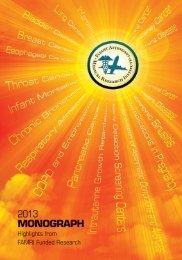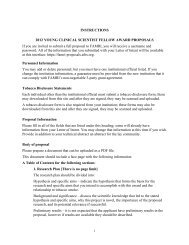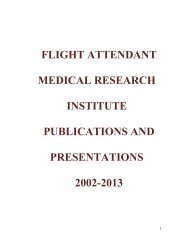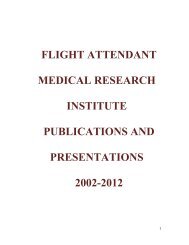MISSION
2009 compendium of FAMRI-supported research - Flight Attendant ...
2009 compendium of FAMRI-supported research - Flight Attendant ...
You also want an ePaper? Increase the reach of your titles
YUMPU automatically turns print PDFs into web optimized ePapers that Google loves.
is to identify and characterize key, novel tumor suppressor genes in breast cancer, and to study the utility<br />
of these genes for diagnostic and therapeutic use. Tumor suppressor genes crucial for oncogenesis are often<br />
targeted by multiple mechanisms of inactivation including mutation and promoter hypermethylation. Dr.<br />
Chan and colleagues hypothesize that tumor suppressors that are key to the development of cancer can be<br />
discovered by identifying common targets of multiple modes of inactivation. As such, the specific aims are<br />
to 1) use combined global mutation and methylation analysis to identify common gene targets of mutation<br />
and hypermethylation; 2) determine whether decreased expression of these “common target” genes predicts<br />
for poor clinical prognosis in breast cancer and evaluate the use of these genes as biomarkers for outcome<br />
in high risk breast cancer patients such as those with tobacco smoke exposure; and 3) determine the<br />
function of the most promising candidate gene and evaluate this candidate as a tumor suppressor and<br />
potential target of epigenetic therapy.<br />
To this end, Dr. Chan and colleagues have developed a microarray approach that enables rapid and accurate<br />
identification of genes silenced by hypermethylation in cancer. They used this technique to identify<br />
genes silenced by hypermethylation in breast cancer. This dataset was then compared to the genes newly<br />
discovered to be mutated in breast cancer (CAN genes). In all, 11 genes were found to be subject to both<br />
mutation and cancer-specific methylation, and will be studied further. The relative roles played by mutation<br />
versus methylation in disrupting gene function in cancer for these genes will be examined. Expression levels<br />
of these 11 common target genes will be analyzed using well-annotated expression microarray datasets<br />
from breast cancers to identify useful biomarkers for diagnosis and prognosis. As tobacco exposure is a<br />
strong risk factor for poor outcome in patients with breast cancer, the use of these new genes as prognostic<br />
biomarkers will be evaluated in breast cancer patients with this risk factor. This information may clarify the<br />
use of adjuvant therapy for this group of high-risk breast cancer patients. Lastly, the molecular details of<br />
the tumor suppressive function of the most promising and clinically significant gene (PTPRD) will be studied<br />
using gene overexpression, RNA interference studies, and biochemical analysis. This study will allow<br />
the discovery of novel cancer genes and explore the utility of these genes as useful predictors of clinical<br />
prognosis and targets for therapy.<br />
FAMRI Supported Publications<br />
Chan TA, Glockner S, Mi Yi J, Chen W, Van Neste L, Cope L, Herman JG, Schuebel KE, Ahuja N, Baylin<br />
SB. Convergence of mutation and epigenetic alterations identified common genes in cancer that predict<br />
for poor prognosis. PLoS Med 2008;5(5):823-838.<br />
Wong J, Armour E, Kazandies P, Iordachita I, Tryggestad E, Deng H, Matinfar M, Kennedy C, Liu Z,<br />
Chan T, Gray O, Verhaegen F, McNutt T, Ford E, DeWeese TL. High-resolution, small animal<br />
radiation research platform with x- ray tomographic guidance capabilities. Int J Radiat Oncol Biol Phys<br />
2008;71:1591-1599.<br />
CANCER, BREAST<br />
COMPLETED RESEARCH<br />
THE ROLE OF LYSINE HISTONE METHYLTRANSFERASE SET 7/9 IN BREAST CANCER<br />
Nickolai A. Barlev, PhD; Tufts-New England Medical Center Hospitals; CIA 2005<br />
Dr. Barlev and collaborators discovered a novel mechanism of p53 regulation, through lysine<br />
methylation, by which p53 is upregulated in response to DNA damage. They investigated the molecular<br />
mechanisms of p53 activation by lysine methylation in response to SHS, using a mammary cell model<br />
system. In addition, they found that lysine methylation is not only required for activation of p53, but is<br />
also necessary for global DNA repair. Elucidation of new downstream targets or effectors of this process<br />
are important.<br />
FAMRI Supported Publications<br />
Morgunkova A., and Barlev, N.A. Lysine methylation goes global. Cell Cycle 5:pp. 1308-12; (2006)<br />
Ivanov, G., Ivanova T., Kurash J.K.A, Ivanov, S., Gizzatullin F., Chuikov, F., Rauscher, D., Reinberg, and<br />
Barlev, N.A. DNA damage activates p53 through a methylation-acetylation cascade. Mol Cell Biol (2008)<br />
AN MVA VACCINE TARGETING p53 IN BREAST CANCER<br />
Joshua Ellenhorn, MD; City of Hope; CIA 2005<br />
The prupose of this project was to develop a vaccine against p53 antigen using an attenuated poxvirus,<br />
modified vaccine Ankara (MVA) as a carrier vehicle to express p53 (MVAp53). The animal model used is a<br />
8 0 P A G E







